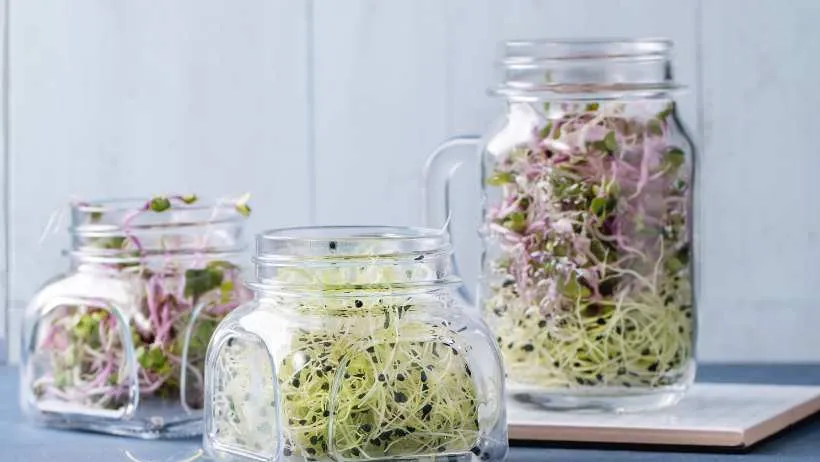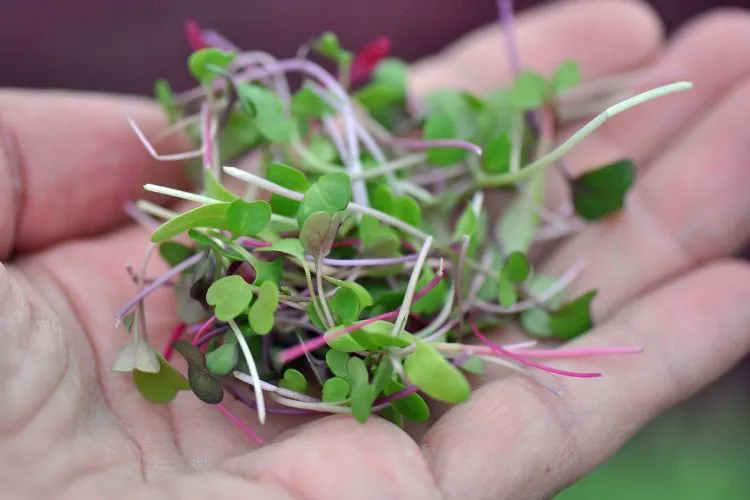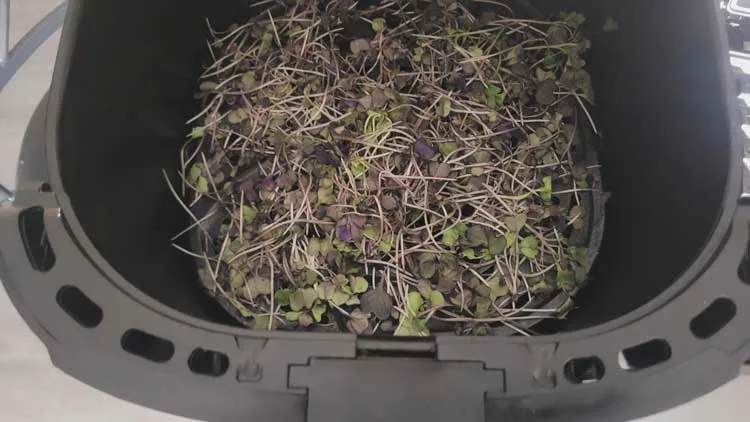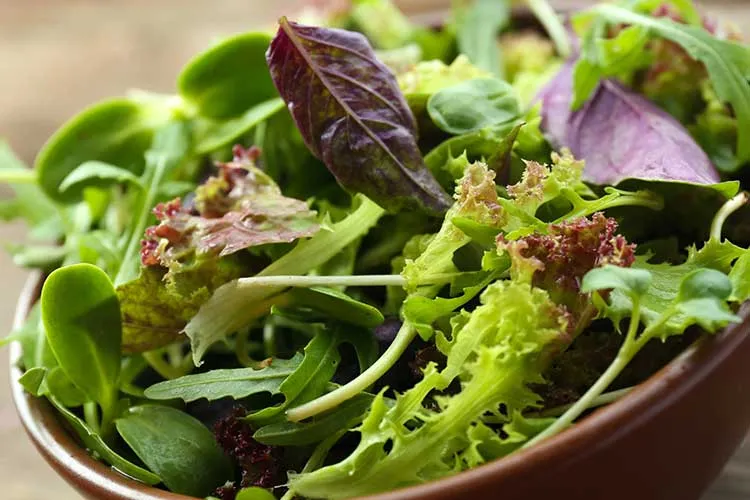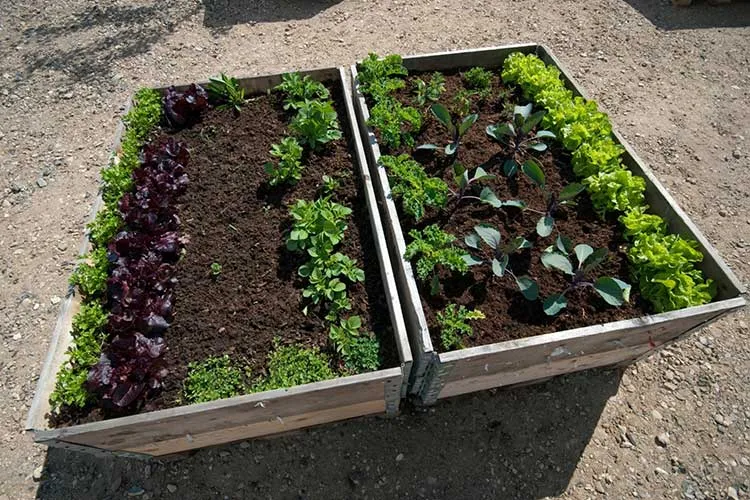Sprouts are among the most nutrient-dense foods you can grow at home, requiring minimal space, time, and effort. Studies show that sprouting increases nutrient availability, boosting vitamins C and K, folate, and antioxidants. Broccoli sprouts, for example, contain up to 100 times more sulforaphane than mature broccoli, a compound linked to cancer prevention.
Despite their small size, sprouts can support digestion, heart health, and immunity. But not all sprouts offer the same benefits. Some are packed with protein, while others are rich in detoxifying compounds. If you’re looking for the best sprouts to grow and add to your diet, this guide will show you which ones stand out nutritionally, how they taste, and the best ways to enjoy them.
The Best Sprouts to Eat and Grow
The best sprouts to grow come in various flavors and textures, each offering unique nutritional benefits. Some taste mild, while others add a spicy or nutty kick to dishes. Whether you’re looking for a vitamin boost, improved digestion, or a crunchy addition to your meals, these sprouts are excellent choices.
Alfalfa Sprouts
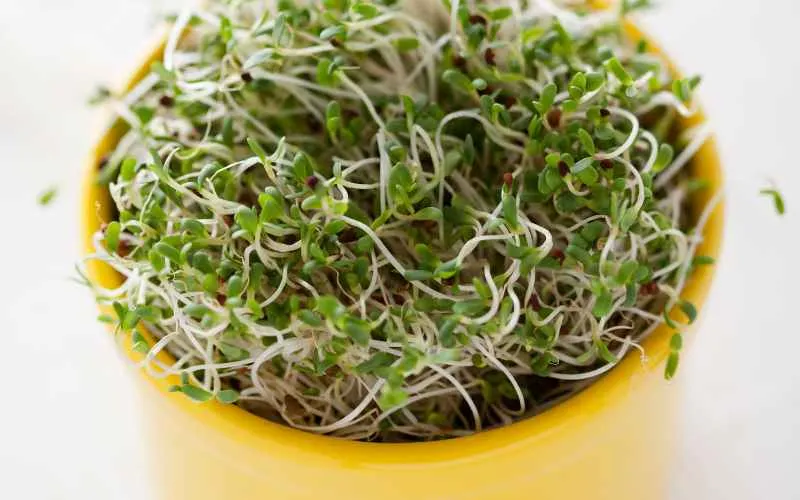
Alfalfa sprouts are delicate, crisp, and mildly flavored, making them a popular choice for adding texture to meals. These tiny sprouts are packed with essential nutrients, including vitamin K, which supports bone health and proper blood clotting.
They also contain phytoestrogens, plant compounds that may help balance hormones and support heart health. Their high fiber content promotes digestion, while antioxidants help reduce inflammation.
Alfalfa sprouts are best enjoyed raw in sandwiches, wraps, or salads. They also work well as a fresh topping for soups and grain bowls.
Broccoli Sprouts
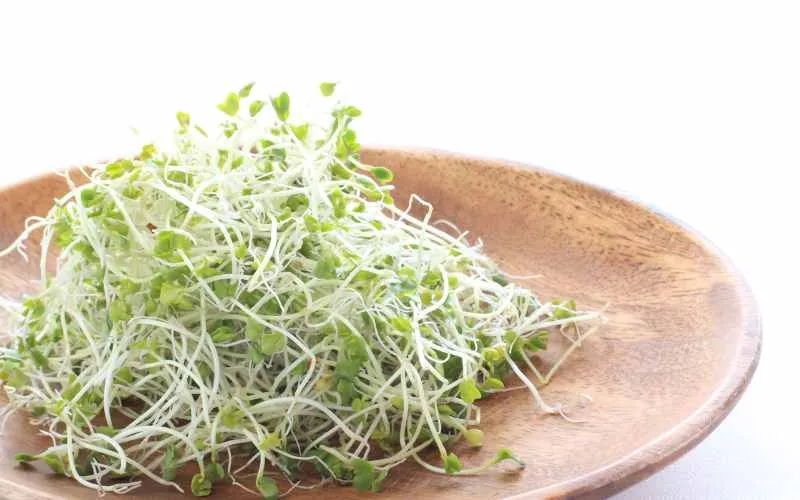
Broccoli sprouts have a mild, slightly peppery taste and are packed with sulforaphane, a powerful antioxidant that supports detoxification and may reduce the risk of certain diseases.
They are also high in vitamin C, which boosts the immune system, and fiber, which aids digestion. These sprouts provide a concentrated dose of nutrients compared to mature broccoli. Broccoli sprouts are best enjoyed raw in salads, sandwiches, or smoothies.
They can also be sprinkled over avocado toast or blended into dips for an added nutritional boost.
Beet Sprouts

Beet sprouts have vibrant red stems and a slightly earthy, mildly sweet flavor. They are an excellent folate source for brain function and cell growth. These sprouts also contain natural nitrates, which help improve blood circulation and support heart health.
Their rich antioxidant content helps reduce inflammation and protect cells from damage.
Beet sprouts add color and nutrition to salads, grain bowls, and omelets. They also pair well with roasted vegetables or can be blended into smoothies for an extra nutrient boost.
Bok Choy Sprouts
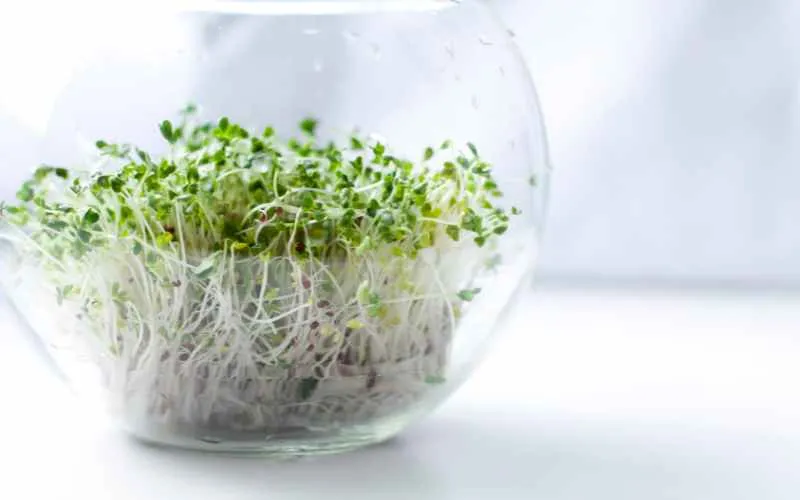
Bok choy sprouts have a mild, cabbage-like flavor with a slight crunch, making them a versatile addition to meals. They are rich in vitamins A and C, which support immune function, skin health, and calcium for strong bones.
Bok choy sprouts also contain antioxidants that help reduce inflammation and protect against cellular damage. They are well-suited for both raw and cooked dishes.
Add them to stir-fries, soups, or noodle bowls, or use them as a fresh topping for salads and wraps.
Fava Bean Sprouts

Fava bean sprouts have a slightly nutty, earthy flavor and a firm texture, making them a hearty addition to meals. They are an excellent source of plant-based protein, fiber, and folate, which supports brain function and cell growth.
These sprouts also contain iron, helping to boost energy levels and improve oxygen circulation. Their dense texture makes them ideal for blending into hummus, adding to stir-fries, or mixing into grain bowls.
They can also be lightly sautéed or tossed into salads for extra nutrition.
Green Pea Sprouts

Green pea sprouts have a fresh, slightly sweet flavor and a crisp texture, making them a great addition to many dishes. They are rich in plant-based protein, fiber, and vitamin C, which support immunity and skin health.
These sprouts also contain iron, which helps boost energy levels and improve oxygen circulation. Green pea sprouts can be tossed into salads, blended into pesto, or added to stir-fries for extra crunch.
They also pair well with soups, sandwiches, and smoothies for a mild, nutrient-rich boost.
Kale Sprouts
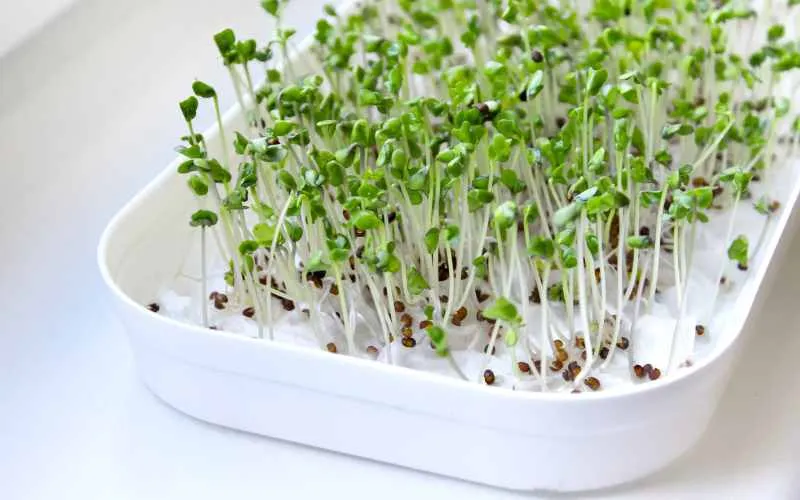
Kale sprouts combine the earthy, slightly bitter taste of kale with the tenderness of sprouts. They are packed with vitamins A, C, and K, which support immune function, skin health, and bone strength.
These sprouts also contain fiber and antioxidants that aid digestion and help reduce inflammation. Their robust nutrient profile makes them a great addition to a balanced diet.
Kale sprouts can be raw in salads, blended into smoothies, or sprinkled over grain bowls. They also pair well with citrus dressings or avocado-based dishes.
Kohlrabi Sprouts
Kohlrabi sprouts have a mild, slightly sweet flavor with a crisp texture, making them a great addition to various dishes. They are rich in vitamin C, which supports immune health and collagen production, and potassium, which helps regulate blood pressure.
Kohlrabi sprouts also contain fiber, which aids digestion and promotes gut health. Their light taste makes them easy to incorporate into meals. Enjoy them in salads, wraps, and slaws, or use them as a fresh topping for sandwiches, soups, and grain bowls.
Mustard Sprouts
Mustard sprouts have a bold, spicy flavor that adds a peppery kick to dishes. They are rich in glucosinolates, compounds known for their detoxifying properties and potential anti-inflammatory benefits.
These sprouts also contain vitamins A, C, and K, which support immune function, skin health, and bone strength. Their strong taste makes them a great addition to sandwiches, grain bowls, and salads.
Mustard sprouts can be sprinkled over soups, mixed into dips, or used as a spicy garnish for roasted vegetables and grilled meats.
Radish Sprouts
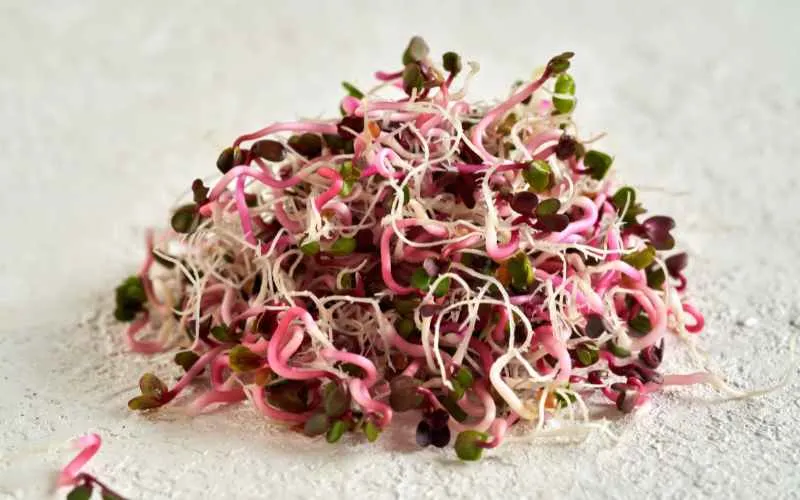
Radish sprouts have a sharp, spicy flavor, adding a peppery bite to dishes. They are rich in vitamin C, which supports immune function, and sulfur compounds that aid detoxification and promote skin health.
These sprouts also contain antioxidants that help reduce inflammation and protect against cellular damage. Their bold taste makes them a great addition to sandwiches, tacos, and salads. Radish sprouts can also be used as a garnish for sushi, blended into dips, or sprinkled over roasted vegetables for an extra kick.
Red Cabbage Sprouts
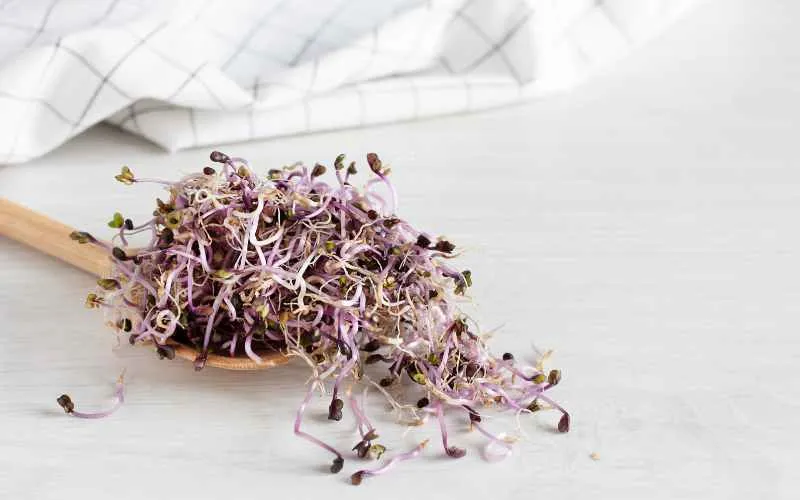
Red cabbage sprouts have a mild, slightly sweet flavor and a crunchy texture. They are packed with anthocyanins, powerful antioxidants that support heart health and brain function.
These sprouts are also high in vitamin C, which boosts immunity and collagen production, and vitamin K, which helps with bone strength. Their vibrant purple color makes them a visually appealing addition to meals.
Red cabbage sprouts can be tossed into salads, layered in sandwiches, or added to grain bowls. They also make a colorful garnish for soups and wraps.
Sunflower Sprouts

Sunflower sprouts have a nutty, slightly sweet flavor with a satisfying crunch. They are rich in vitamin E, which supports skin health and reduces inflammation, and magnesium, which helps with muscle function and relaxation.
Sunflower sprouts are also a good source of protein and healthy fats, making them a great addition to a balanced diet. They can be enjoyed in salads, sandwiches, or wraps.
They also pair well with smoothies, scrambled eggs, or as a garnish for roasted vegetables and grain bowls.
What Are Sprouts?
Sprouts are young plants that emerge when seeds germinate. They grow in water or a moist environment without soil, typically within a few days. As they develop, sprouts produce tiny stems and leaves, making them a fresh, crunchy addition to meals.
The sprouting process involves soaking seeds to activate enzymes, which break down stored nutrients and make them easier to digest. This rapid growth also boosts the availability of vitamins, minerals, and antioxidants, making sprouts highly nutritious.
Are Microgreens the Same as Sprouts
Sprouts differ from microgreens in both growth methods and nutritional content. While sprouts are grown in water and eaten whole, including the root, microgreens grow in soil or a growing medium and are harvested only for their leaves and stems.
Microgreens take longer to mature and usually have a stronger flavor, while sprouts have a milder taste and a softer texture. Both are nutritious, but due to their early stage of development, sprouts tend to have more enzymes that aid digestion.
Why Raw Sprouts Are Popular in Healthy Eating
Sprouts are widely used in healthy eating because they are nutrient-dense, easy to grow at home, and provide a fresh source of vitamins and minerals year-round, even in small spaces.
Many enjoy adding them to salads, sandwiches, and smoothies to boost flavor and texture. Their high enzyme content supports digestion, and their antioxidant properties contribute to overall well-being.
Because they require minimal effort and grow quickly, sprouts are a convenient way to add more fresh, living foods to a daily diet. However, there are risks associated with consuming raw sprouts.
Health and Nutritional Benefits of Sprouts
Sprouts offer various health benefits, from improved digestion to better heart health. Because they are harvested early, their nutrient levels are highly concentrated.
They contain fiber, enzymes, and antioxidants that support overall wellness. Regularly adding sprouts to meals can improve gut health, strengthen immunity, and even manage weight.
Digestive Health
Sprouts are rich in fiber, which promotes healthy digestion and prevents constipation. The sprouting process also increases enzyme production, making nutrients easier to absorb. These enzymes help break down complex carbohydrates and proteins, reducing bloating and discomfort.
Many people with digestive issues, such as irritable bowel syndrome (IBS), find that sprouts are gentler on their stomach than fully matured vegetables. Since sprouts contain prebiotics, they can also support gut bacteria, improving overall gut health.
Heart Health
Eating sprouts regularly may support heart health by lowering cholesterol and blood pressure. Some varieties, like broccoli and alfalfa sprouts, contain compounds that reduce LDL (bad) cholesterol while increasing HDL (good) cholesterol.
The fiber in sprouts also helps regulate blood sugar levels, reducing the risk of diabetes-related heart disease. Additionally, sprouts are a good source of potassium, which helps relax blood vessels and maintain healthy blood pressure. The antioxidants found in sprouts may also protect against oxidative stress, which can lead to heart disease over time.
Immune System Support
Sprouts contain antioxidants like vitamin C and flavonoids, which help fight free radicals and strengthen the immune system. Some, like broccoli sprouts, are particularly high in sulforaphane, a compound known for its anti-inflammatory and detoxifying properties.
These nutrients help the body combat infections and may reduce the risk of chronic diseases. Because sprouts are a fresh, living food, they also provide essential vitamins that support immune function, making them a great addition to a diet focused on overall health.
Other Benefits
Sprouts can also aid in weight management due to their low calorie and high fiber content, which helps keep you full longer. They contain vitamins and minerals that support healthy skin, reducing inflammation and promoting a natural glow. Their high nutrient density also makes them beneficial for energy levels and overall wellness.
How to Grow Sprouts at Home
Growing sprouts at home is simple, requires minimal space, and provides a fresh supply of nutrient-rich greens year-round. With just a few basic supplies and the right conditions, you can enjoy a variety of sprouts within days.
Choosing Seeds
Select high-quality, organic, and untreated seeds specifically labeled for sprouting. Some regular garden seeds may be treated with chemicals, making them unsafe to eat raw. Look for trusted sources that test seeds for bacterial contamination.
Popular choices include alfalfa, broccoli, radish, mung bean, and sunflower seeds. If buying in bulk, store seeds in a cool, dry place to maintain freshness.
Step-by-Step Growing Process
- Soaking: Place 1 to 2 tablespoons of seeds in a clean jar or sprouting container. Fill the jar with water, ensuring the seeds are fully submerged. Depending on the variety, let them soak for 6 to 12 hours. Larger seeds, like mung beans or peas, need longer soaking times.
- Draining and Rinsing—Drain the water using a fine-mesh lid or cheesecloth after soaking. Rinse the seeds with fresh water and drain again. Repeat this process twice a day to prevent mold and encourage sprouting.
- Sprouting – Keep the jar tilted at an angle to allow excess water to drain while ensuring good airflow. Place it in a spot with indirect sunlight and room temperature (65–75°F). Within 2 to 7 days, depending on the seed type, tiny sprouts will start to emerge.
- Final Rinse and Harvesting: Once the sprouts reach the desired length (usually 1 to 3 inches), rinse them to remove the seed husks. Drain well and let them dry slightly before storing.
Common Mistakes to Avoid
Excess moisture can lead to mold, so drain sprouts thoroughly after rinsing. Poor air circulation increases the risk of bacterial growth, so avoid sealing sprouts in an airtight container while they are still damp.
Using untested seeds may introduce contaminants, so always choose seeds labeled for sprouting. Lastly, avoid overfilling the jar, as overcrowding can cause uneven sprouting and increase the risk of spoilage.
Safety Tips: How to Eat Sprouts Without Risk
While sprouts are packed with nutrients, they can also carry bacteria like E. coli and Salmonella due to the warm, moist conditions needed for sprouting. Proper handling and storage reduce the risk of foodborne illness, making sprouts safer to enjoy.
Risks of Eating Raw Sprouts
Raw sprouts have been linked to foodborne illness outbreaks because bacteria can thrive in the humid environment where sprouts grow. Contaminated seeds are the most common source of bacteria, and since sprouts are usually eaten raw, cooking doesn’t kill harmful germs.
People with weakened immune systems, pregnant women, young children, and older adults should be especially cautious when consuming raw sprouts.
How to Avoid Getting Sick from Sprouts
To reduce the risk of illness, always buy high-quality seeds tested for pathogens. Wash hands, jars, and sprouting equipment thoroughly before and after handling sprouts. Rinse sprouts well under running water before eating.
If you are concerned about safety, lightly cooking sprouts—such as stir-frying, steaming, or adding them to soups—can eliminate bacteria while retaining some nutritional benefits.
Proper Storage Methods
Store sprouts in a clean, breathable container lined with a paper towel to absorb excess moisture. For the best freshness, store them in the refrigerator at or below 40°F and consume them within 3 to 5 days.
Avoid leaving sprouts at room temperature for extended periods, encouraging bacterial growth. If sprouts develop an unusual smell, slimy texture, or discoloration, discard them immediately.

